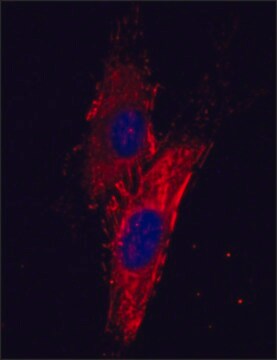추천 제품
product name
Anti-Fibronectin Frag Antibody, cell attachment fragment, clone 3E3, clone 3E3, Chemicon®, from mouse
생물학적 소스
mouse
Quality Level
항체 형태
purified immunoglobulin
항체 생산 유형
primary antibodies
클론
3E3, monoclonal
종 반응성
human
제조업체/상표
Chemicon®
기술
ELISA: suitable
immunocytochemistry: suitable
immunohistochemistry: suitable
western blot: suitable
동형
IgG1
UniProt 수납 번호
배송 상태
wet ice
타겟 번역 후 변형
unmodified
유전자 정보
human ... FN1(2335)
특이성
The antibody reacts with human fibronectin and with a peptic fragment (11.5 kD) from human fibronectin (Pierschbacker et al., 1981) comprimising the cell attachment site (Pierschbacker et al., 1981; Pierschabacker et al., 1983, 1984; Hayman et al., 1985; Ruoslahti et al., 1986; Hynes, 1985). It inhibits the attachment of normal rat kidney cells to human fironectin coated plastic surface (Pierschbacker et al., 1981). Binding of the antibody to fibronectin cannot be inhibited by cell adhesion peptides from fibronectin having the sequence Arg-Gly-Asp of Gly-Arg-Gly-Asp-Ser (Pierschabacker et al., 1984; Hayman et al., 1985; Ruoslahti et al., 1986).
면역원
Epitope: cell attachment fragment
Purified human-fibronectin from amnion liquid.
애플리케이션
Anti-Fibronectin Frag Antibody, cell attachment fragment, clone 3E3 is an antibody against Fibronectin Frag for use in ELISA, WB, IC, IH.
Immunocytochemistry: (5-20 μg/mL) Immunohistochemistry: (5-20 μg/mL) (Not tested on paraffin sections) Immunoblotting: (5-20 μg-mL)
ELISA
Inactivation or inhibition studies in cell culture.
Optimal working dilutions must be determined by end user.
ELISA
Inactivation or inhibition studies in cell culture.
Optimal working dilutions must be determined by end user.
Research Category
Cell Structure
Cell Structure
Research Sub Category
ECM Proteins
ECM Proteins
물리적 형태
Format: Purified
Purified immunoglobulin. Liquid in 0.02M Phosphate buffer, 0.25M NaCl with 0.1% sodium azide.
저장 및 안정성
Maintain at 2-8°C in undiluted aliquots for up to 6 months.
기타 정보
Concentration: Please refer to the Certificate of Analysis for the lot-specific concentration.
법적 정보
CHEMICON is a registered trademark of Merck KGaA, Darmstadt, Germany
면책조항
Unless otherwise stated in our catalog or other company documentation accompanying the product(s), our products are intended for research use only and are not to be used for any other purpose, which includes but is not limited to, unauthorized commercial uses, in vitro diagnostic uses, ex vivo or in vivo therapeutic uses or any type of consumption or application to humans or animals.
적합한 제품을 찾을 수 없으신가요?
당사의 제품 선택기 도구.을(를) 시도해 보세요.
Storage Class Code
12 - Non Combustible Liquids
WGK
WGK 2
Flash Point (°F)
Not applicable
Flash Point (°C)
Not applicable
시험 성적서(COA)
제품의 로트/배치 번호를 입력하여 시험 성적서(COA)을 검색하십시오. 로트 및 배치 번호는 제품 라벨에 있는 ‘로트’ 또는 ‘배치’라는 용어 뒤에서 찾을 수 있습니다.
Surface chemistry modulates fibronectin conformation and directs integrin binding and specificity to control cell adhesion.
Benjamin G Keselowsky, David M Collard, Andres J Garcia
Journal of Biomedical Materials Research Part A null
Mechanism(s) of increased vascular cell adhesion on nanostructured poly(lactic-co-glycolic acid) films.
Miller, Derick C, et al.
Journal of Biomedical Materials Research Part A, 73, 476-484 (2005)
Molecular biology of fibronectin.
Hynes, R
Annual Review of Cell Biology, 1, 67-90 (1985)
Angela Orecchia et al.
Journal of cell science, 116(Pt 17), 3479-3489 (2003-07-17)
Vascular endothelial growth factor receptor-1 (VEGFR-1) is a tyrosine kinase receptor for several growth factors of the VEGF family. Endothelial cells express a membrane-spanning form of VEGFR-1 and secrete a soluble variant of the receptor comprising only the extracellular region.
Tiffany M Tsang et al.
The Journal of biological chemistry, 287(20), 16759-16767 (2012-03-27)
The Yersinia pestis adhesin molecule Ail interacts with the extracellular matrix protein fibronectin (Fn) on host cells to facilitate efficient delivery of cytotoxic Yop proteins, a process essential for plague virulence. A number of bacterial pathogens are known to bind
자사의 과학자팀은 생명 과학, 재료 과학, 화학 합성, 크로마토그래피, 분석 및 기타 많은 영역을 포함한 모든 과학 분야에 경험이 있습니다..
고객지원팀으로 연락바랍니다.